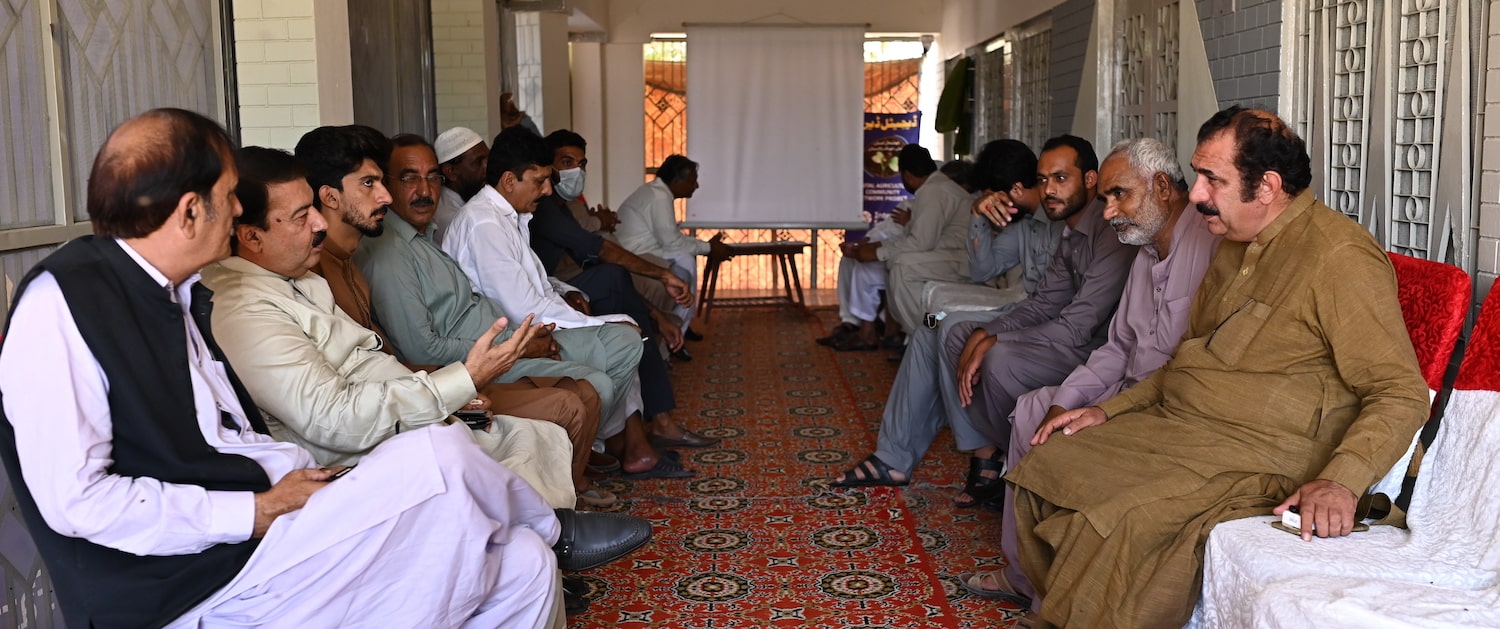
Combining Revolutionary Technologies to Grow a Better Future
What happens when two technical revolutions collide? Digital Dera unleashes human potential.
Bashir Hussain, a small-scale farmer in rural Pakistan, was facing a dilemma. If he made the wrong choice he’d be out of money he couldn’t afford to lose.
During the last days of 2021, his friend called to warn him that the rainy season would start in a little over a week. He should hold back from spraying pesticide on the potato crop.
Bashir was unsure about the advice. He wasn’t expecting rain that week, and if he didn’t spray in time, the potato crop would suffer, bringing a lower price in the market. But if it rained after he sprayed the crop, he risked losing his entire stock of pesticide, which he had bought on credit. The quality of potatoes would drop, too, resulting in a double loss to his earnings.
The clock was already ticking. He was in a hurry to harvest and sell the potato crop so he could pay off his creditors and earn enough to support his family over the next few months.
Bashir ended up following his friend’s advice. He held off on the spray. Then the torrential rains came. He had made the right choice.
He was able to avoid financial loss and maintain his crops due to timely information. His friend, also a farmer, was able to share this critical knowledge because of a groundbreaking initiative: Digital Dera. It’s where he goes to get the latest weather forecast—from the Internet.
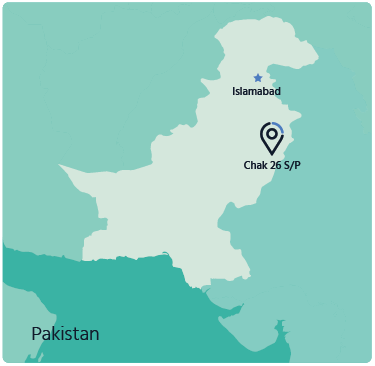
Dera is a common term in South Asia. It’s a shared space where villagers meet, discuss, and socialize over a cup of tea, usually in the evening. The farmhouse, where the Dera is often located, is commonly owned by the head of the village, open to anyone who wishes to join.
Digital Dera is a brand new community network, serving farmers in a rural village called “Chak 26 S/P” in South Pakistan. Less than a year old, it’s already saved about 70 percent of the farmers in the village money and effort by providing the kind of timely information Bashir received. These make-or-break decisions are made by millions of farmers worldwide every day. Accurate information shared in advance is critical. Digital Dera set out to help by bringing technology to the agriculture sector in Pakistan.
Digital Dera got its start over a cup of coffee. In the summer of 2020, Naveed Haq, the Internet Society’s director of infrastructure and connectivity, was catching up with his old friend Fouad Bajwa in Lahore, Pakistan. The two were discussing past projects when the lightbulb went off. Naveed had helped build a community network and an online remote education facility in Chak 5 Faiz village in rural Pakistan. Fouad, an agriculture technologist, had co-founded the startup Agriculture Republic, which develops solutions for farming, food security, and climate change challenges. Knowing the digital gap in the agriculture sector, they both resolved to bring Internet to the farmer community. From there, a partnership was born. The Internet Society and Agriculture Republic joined hands to deploy Pakistan’s first-of-its-kind digital agriculture community network.
Preparing the Ground
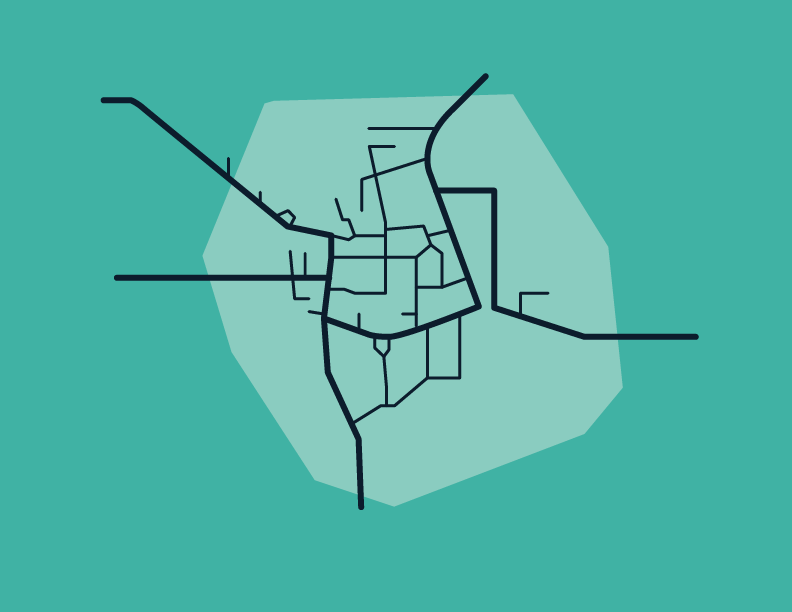
Naveed and Fouad are technologists, so they needed a farmer-at-heart who understood and could help identify community challenges and how a network could help. They reached out to Amer Hayat Bhandara, a progressive farmer and the co-founder of Agriculture Republic. He named one community facing daunting challenges in making the most of the land’s productivity: Chak 26 S/P.
Chak 26 S/P is one of the most fertile lands in Pakistan. But up until recently, its communications landscape was relatively barren. The area has no broadband, no fixed-line infrastructure, and poor cell phone reception. The community, made up of roughly 7,000 residents living in 1,200 households, had been struggling to bring social and economic development.
With rising inflation, the pandemic, and other economic issues in Pakistan, they were fighting to sustain their income level. Without reliable communication services, the community couldn’t access timely and up-to-date information about weather changes, COVID-19 prevention and control, agri-medicines, supply chain management, and the latest innovations in the agriculture sector.
Khizar, a small-scale farmer, says, “I come from a generation of farmers, but never have I witnessed such tough times where I can barely make ends meet. The government is revoking subsidies and putting more taxes on everything. I had to sell a quarter of my livestock this winter to buy essentials for harvesting the crop.”
In spite of ideal land and weather conditions, the village’s per acre crop yield has been far below ideal. It’s a result of ill-informed decision-making, high input prices, and unpredictable weather patterns. The government has worked to bring technology to the farming sector, with innovations like a disaster management system and a livestock farmer database, but these were inaccessible and insufficient for Chak 26 S/P, given their lack of connectivity. The community wanted to be self-sufficient. Internet access was the key to getting the information they needed, rather than being dependent on word of mouth and hearsay. A community network would be the perfect solution.
Agriculture and Digital Adoption
Pakistan is the world’s fifth-most populous country, with a little over 200 million people, and agriculture is the backbone of its economy Nearly two-thirds of its people depend on agriculture for their livelihood, contributing 19.2 percent to the GDP. But shrinking arable land, climate change, water shortages, and a large-scale population and labor shift from rural to urban areas is making it more difficult for farmers to earn a living. In an interview last year, Zulfikar Awan, president of the organization Pakistan Kissan Ittehad (which translates to “Pakistan Farmers’ Unity”) said, “The minimum support price for wheat was 1,400 rupees—we never even got that. Fertilizer was at 2,500 rupees, now it’s 4,500 rupees; [farming product] urea was 1,300 rupees, now it’s 1,800 rupees. There is so much input-output disparity for Pakistani farmers that our produce just cannot compete with other countries.”
At the same time, Pakistan is at the crossroads of the technology revolution. Prime Minister Imran Khan launched the Digital Pakistan Vision in 2019. According to Pakistan Telecommunication Authority (PTA), the country had more than 188 million cellular subscribers and 110 million broadband subscribers by November 2021, while 77 percent of the population has access to 3G or 4G service. Still, the digital divide and poor network performance are significant hurdles in Internet usage. Some 62 percent of the population lives in rural areas where broadband coverage and quality of service have yet to reach a good level of reliability and affordability. The fusion of digital technologies and agriculture should come as a logical priority for the government and private sector, but there is little proof that agritech has been able to gain any momentum in Pakistan.
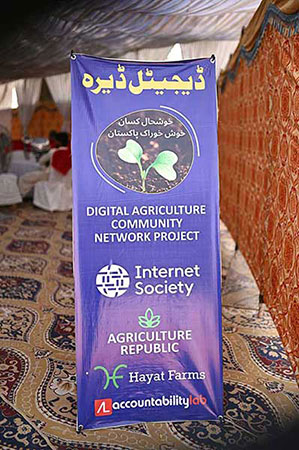
Champions at Work
Digital Dera isn’t just changing farming practices in Chak 26 S/P, it’s forging new opportunities for many residents and helping their dreams take shape. Community networks champions Mohsin, Rehan, and Babar don’t have formal education or certification in networking, but they’re keen to learn and volunteer—and they’re already making big plans.
Mohsin wants to use the Internet to teach children in his village who can’t go to school due to COVID-19 lockdowns. With the Internet, kids in Chak 26 S/P could have educational opportunities that are out of reach for many. Some 44 percent of children in Pakistan aged five to 16 do not attend school.
Chak 26 S/P residents face other barriers to education. To take an online class, Babar used to travel 20 kilometers each day to an Internet cafe. To save money, he and local classmates would take turns traveling to the Internet cafe for class. When they returned to the village, they’d share notes. Now that they have Internet at the Dera, they want to pool their money to buy a used laptop so that they can take the class together.
Rehan in inspired by the success of Mubashir Saddique, a villager who runs a successful YouTube channel, “Village Food Secrets,” with 3.4 million subscribers. He wants to become a vlogger to share agricultural tips with the world.
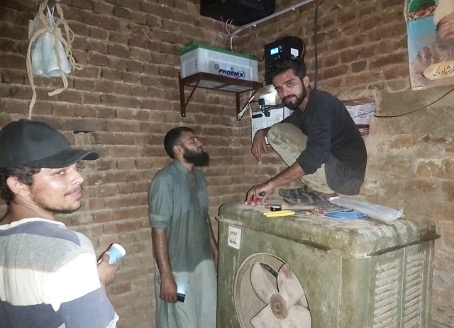
Community networks champions Mohsin, Rehan, and Babar working at the leading transmission site in Hayat Farms
The Digital Dera project was ambitious. It required persistence and commitment from the organizing partners and the community it would serve. Even more complex was finding the right place to execute the project out of 51,000 villages in Pakistan. But Chak 26 S/P was a perfect fit for it.
Chak 26 S/P is located in the Pakpattan District in Punjab, the largest province in the country by population. Punjab is also known as the breadbasket of Pakistan. It has vast irrigable land that contributes about 68 percent to the annual food grain production in the country. Fifty-one million acres of land are cultivated, and another 9.05 million acres are lying as cultivable land not being used in different parts of the province.
Considered one of the most fertile lands in the area, Chak 26 S/P is made up primarily of low-income land and dairy farmers. They grow potatoes, rice, and corn. While most regions produce two crops per year, Pakpattan yields three crops per year.
In September 2021, unexpected rainfall severely damaged rice fields in the village. It caused a loss of productivity of 20-25 percent, about a 30 percent loss of selling price due to quality deterioration, and the opportunity cost of harvesting cultivable land. With a proper weather forecast and warning system they could have reduced the damage. A community network would help.
Deploying a Community Network
To deploy any community network, you must address three challenges: active community involvement, regulatory barriers, and sustainability. In Chak 26 S/P, the Internet Society and local partners mobilized the community by recruiting volunteers. Known as community network champions, these were locals with no formal Internet education who were willing to learn about and support the project. These champions were trained by the Internet Society to deploy and maintain the community network. In addition, local vendors surveyed the area and recommended the best network design and equipment.
The Digital Dera was designed as a wireless mesh network, with a leading transmission site connecting Chak 26 S/P and four other villages through receiving network bridges. The leading transmission site was installed at Hayat Farmswhich already equipped with essential utilities. It’s powered by solar energy, taking into account rising energy prices in Pakistan and environmental impact. Champions took over the deployment phase with the assistance of local vendors. With the nearest ISP exchange located 15 kilometers away, there was no direct access to backhaul. Instead, the champions established a point-to-point link of 7 Mbps from the exchange tower to Hayat Farms, near the village.
During the project’s first phase, Chak 26 S/P was given priority. Later, Digital Dera will provide Internet access to receiver stations in the following order: Chak no. 28 S/P, Chak Sethanwala, Chak Faridpur, Chak Sohail. Naveed hopes that the “empowered community of the Chak 26 S/P will inspire the other four villages to embrace the project whole-heartedly and generate interest among the farmers to use technology.” He envisions Digital Dera as the hub of agriculture innovation, growing throughout Pakistan through a sustainable operational model led by the community.
This will empower the farmers and bring about efficient use of resources.”
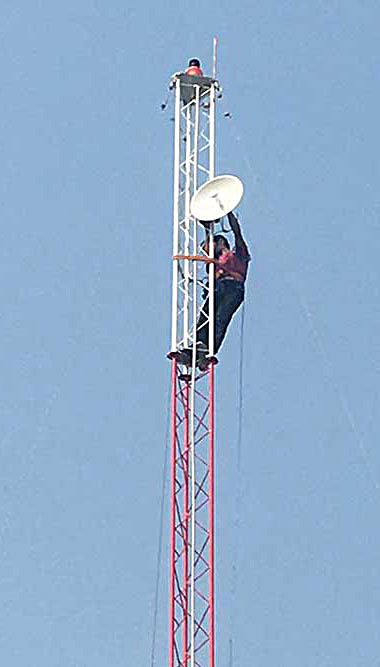
The Digital Dera office at Chak 26 S/P is three kilometers from Hayat Farms. It has a training room that can accommodate up to 200 and an air-conditioned workspace—a friendly place to get things done, given the hot climate in Pakistan throughout the year. Visitors can access the Internet with three workstations and three tablets, plus use the printer and multimedia projector. Everything is operated and maintained by champions. The office is also used to train farmers and anyone interested in becoming a community network champion.
Pakistan does not have a specific license or any regulatory framework for community networks. But the government’s Directorate General Agriculture (DGA) was confident about the project and its potential to improve lives. Digital Dera was inaugurated 2 October, 2021 by the DGA’s Director General Agriculture (Extension and Adaptive Research) Muhammad Anjum Ali. The Punjab government was showing tremendous support for the project.
Naveed says, “We are bringing this digital agriculture community network concept to apply technology into agriculture practices. This will empower the farmers and bring about efficient use of resources.”
Internet for Family Legacy
Malik Malik Sarwar (right) is a seasoned and respected farmer in Chak 26 S/P. Regarded as a wise counselor and expert on farming in the village, local small-scale growers often look to him for insights and forecasts during harvesting and beyond. Over the years, he’s saved them money and effort by sharing advance information, and sometimes warning, about new pesticides, fertilizers, and agri medicines. He enjoys the honor and respect his counsel brings to him and his family.
But with changing times—and a changing climate—he was finding this elderly role to be increasingly difficult. A believer in technology, he often used the agriculture extension services provided by the government. But the lack of a quality network, and the corresponding delay in accurate information, made it difficult to make judgments about the weather changes. Malik is ecstatic to see that Digital Dera has brought Internet to the village. He’s taken a training session at the Dera, and he’s confident it will make him more informed and educated about farming and climate, leading to Chak 26 S/P’s collective prosperity. He encourages fellow farmers to attend training at the Dera. He hopes the Internet will be available throughout the entire village someday.
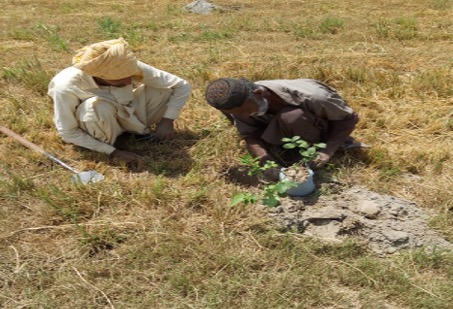
A New World of Opportunities
The Digital Dera is available round the clock, with ten to fifteen farmers visiting each day. The champions are there to help with the Internet and address language and digital literacy barriers. Using their native language, farmers share concerns related to crops, livestock, fertilizer, vegetation, weather, disease, pest control, and farming techniques. The champions at the Dera listen and support the farmers in lots of ways:
- Search for the query/information on the web and Government portals.
- Connect the farmer with agriculture officials over a video link.
- Train the farmers on using their phones to search for information.
- Provide updated market prices and other costs.
- Inform the farmers about the latest loan and credit facilities offered by Govt/banks.
- Provide weather updates and rain/dry seasons forecasts.
- Brief the villagers about agronomy and the latest farming techniques.
- Advise the farmer on prolonging land life and conservation of water resources.
Digital Dera has become an agriculture hub, opening a new world of opportunities in Chak 26 S/P. Before the project, farmers relied upon word-of-mouth and experience to make decisions with high financial stakes. Now they can go to Digital Dera each day for accurate, updated, and verified information.
Village leaders are taking notice, too. Small farmers follow the advice and guidance of the leaders whenever it’s time to make crucial decisions for their crops. The community network has been able to attract the attention of village leaders in Chak 26 S/P and beyond—a critical factor in Digital Dera’s outreach. Gaining the confidence of the village heads helps spread the information faster into the farmer community.
The positive exposure to Internet has helped the community understand the importance and use of Information and Communication Technologies (ICTs). One of the most significant challenges in bridging the digital divide in Pakistan has been a negative mindset about the mobile and Internet. A 2021 GSMA study revealed that family disapproval is consistently the critical reason women cannot own mobile phones in the country. It is a significant socio-cultural barrier where elders in rural areas think that the Internet and mobile phones are sources of indecent entertainment and unwanted socialization. The Digital Dera will help break this cultural mindset by demonstrating positive use of the Internet by showing practical use cases.
The real-world benefits of connecting to the Internet via Digital Dera are hard to deny, though.
Connecting to Low and No Interest Loans
Before Digital Dera, farmers were burdened by loans and credits given by local landlords with high interest rates loans and strict re-payment terms and conditions. The alternative was traveling far to government offices or banks to apply for loans and credit. Now, farmers can visit the welcoming Dera, print out application forms, and even submit online applications. They’re also learning about interest-free loans, such as like e-Kissan, offered by government of Punjab.
The Punjab Information Technology Board has also started an initiative, in partnership with the Agriculture Department of Punjab, to provide interest-free loans to small farmers. Farmers can use microcredit facilities and digital financial resources to obtain credit and manage it online. About 110,000 farmers are provided with free mobile phones, each one having a mobile wallet through which the loan is disbursed. Government officials from the Agriculture Department, called field assistants, visit the villages and advise the farmers as well.
Once all [Digital Dera] sites are up, I can speak with 100 farmers at the same time over the Internet, rather than going from village to village.”
Before Digital Dera, it was difficult for the farmers to reach the officials. Chak 26 S/P is the center of local administrative unit that’s made up of 13 villages and approximately 20,000 people. Yet there is just one field assistant assigned to area. Now, Digital Dera connects the farmers with the Agriculture Department representatives over video links to discuss the crop cycle, harvesting, plowing, and pest-prevention measures free of cost. The farmers save time, money, and effort and the government can reach out to the community more easily. It’s become such a win-win, that farmers near Chak 26 S/P have asked Digital Dera for a similar project in their villages.
“I used to spend so much time and fuel to travel from one place to the other. Sometimes, I would arrive too late to offer any help on urgent matters being faced by the farmers. Once all [Digital Dera] sites are up, I can speak with 100 farmers at the same time over the Internet, rather than going from village to village,” says Ghulam Farid, a field assistant for Chak 26 S/P’s administrative unit.
The Future of Digital Dera
Digital Dera’s next big step is achieving sustainability and scalability, and the local team is talking with potential partners. The Internet Society has assured the project is sustainable in terms of Internet connection and electricity cost until the end of 2022. Beyond that, the Digital Dera will continue to run with the support of local companies and farmers. They’re also piloting agritech solutions to create awareness among the farmers of innovative digital solutions—and the technology benefits and efficiency they can bring. These are a soil and moisture management system, precision agriculture using satellite mapping, and farming input automation.
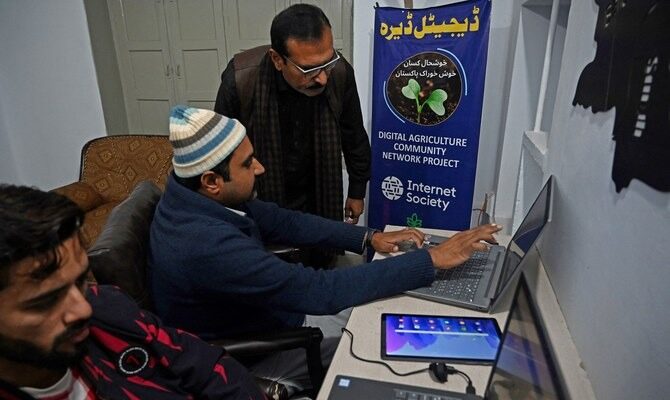
The Digital Dera demonstrates the technology in practice for prospective investors and entrepreneurs. An example is a tube well that was automated in the village, where a farmer can turn the water flow on or off from his mobile phone. Under existing circumstances, farmers install an electric bulb at the well (usually hundreds of meters away) to monitor electricity availability. In addition, a dedicated employee has to start the well once the power comes back on. With the deployment of this pilot solution, farmers can cut down operational costs by removing the bulb and human resources. Imagine if this successful pilot was to be implemented across the 1.2 million tube wells in Pakistan, how much energy and cost could be saved since electricity at tube wells is taxed heavily by the Government of Punjab. Moreover, how many million cusecs of water could be conserved since Pakistan is approaching absolute water scarcity by the year 2025.
Digital Dera is well on its way to becoming an agriculture and food security innovation lab—where startups and investors from around Pakistan can see how their innovations work with real farmers. It aims to be an agritech incubator, inspiring farmers and developrs to embrace the concept of Agriculture 2.0.
Through digital inclusion in the rural areas, Digital Dera is enabling farmers to decide effectively, efficiently, and smartly using data, information, guidance, and technology. With strong potential to be replicated across the country, the end result could be a sustainable, productive, and food secure future of Pakistan.
Amer Hayat Bhandara, the co-founder of Agriculture Republic, certainly hopes so. ”It gives our farmers hope of a better future, and to us of a better Pakistan.”
Image copyrights: © Imran Khattak